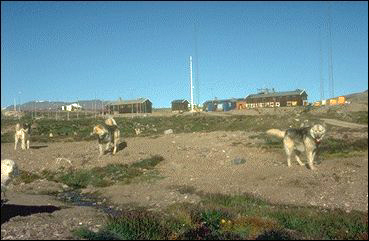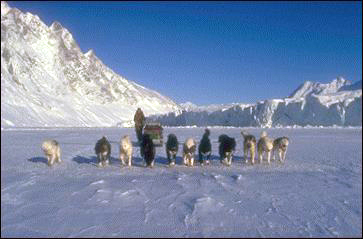Table of Contents
*
F.I.D.O.: Peter Schmidt Mikkelsen
*
A Conversation with Palle Norit
*
DNA Analysis of the Greenland Dog and the Canadian Inuit Dog
*
Pregnancy, Whelping and Pup Development in the ISD, Part 1
*
Product Review: Herculiner®
*
Tip for the Trail: Anti-fatigue Mats
*
In the News
*
Janice Howls: At the Heart of Greatness
*
IMHO: Training or Interference
Navigating This
Site
Index of articles by subject
Index
of back issues by volume number
Search The
Fan Hitch
Articles
to download and print
Ordering
Ken MacRury's Thesis
Our
comprehensive list of resources
Talk
to The
Fan Hitch
The Fan
Hitch home page
ISDI
home page
Editor's/Publisher's Statement
Editor: Sue Hamilton
Webmaster: Mark Hamilton
The Fan Hitch welcomes your letters, stories, comments and suggestions. The editorial staff reserves the right to edit submissions used for publication.
Contents of The Fan Hitch are protected by international copyright laws. No photo, drawing or text may be reproduced in any form without written consent. Webmasters please note: written consent is necessary before linking this site to yours! Please forward requests to Sue Hamilton, 55 Town Line Rd., Harwinton, Connecticut 06791, USA or mail@thefanhitch.org.
This site is dedicated to the Inuit Dog as well as related Inuit culture and traditions. It is also home to The Fan Hitch, Journal of the Inuit Sled Dog.

August at Sirius Patrol headquarters in Daneborg Mikkelsen photo
A May 2003 Conversation with Palle
V. Norit,
Former/retired Commanding
Officer,
Patrol Branch North and Northeast
Greenland,
Sirius Patrol, 1990 - 2001
T.F.H. Can you
start by giving
us an overview of the Sirius Patrol and its purpose?
P.N. I use to brag that Sirius is the oldest
special force in
the world because we have had the same purpose, manning,
setup, area of
responsibility everything, since the start 18 August 1950
- 1) Maintain
Danish sovereignty in the area, 2) Police jurisdiction, 3)
Military surveillance.
International law (5 April 1933) describes that one actually has to tread the ground one possesses. No aeroplanes, no satellite, no snowmobile can do that. Are dog powered patrols still the most efficient and cost effective way to get the job done? Yes, and one's way of observing multiplies 10,000 by being close to the nature.
T.F.H. We'd like
to know more about
the dogs the Sirius Patrol uses. Please tell us a
little about them, where
they came from and what they are like.
P.N. Very difficult to tell, because Sirius has a
special way
of selecting dogs. Most likely the dogs came from the
whole "ice area"
in the North (Canada, Siberia, Greenland). Sirius has got
blood from Antarctica
(via USA), from West Greenland and from Scoresbysund,
making sure we are
well away from any close family relations. Sirius goes for
a long-legged,
short-haired, upright ears, square and gentle dog.
T.F.H. Maintaining
dog teams to
support Sirius Patrol's responsibilities must be a
significant effort involving
many people. Can you tell us about this process: the
scope of the program,
any use of breeding facilities, and the process and
criteria used for selecting
dogs for breeding?
P.N. Definitely; there are two selected patrol
members checking
the dogs, together with the drivers.
Bitches whelp both en route during sled runs and at Daneborg by the so called "Station Bitches". E.g. when the bitches selected are "red", we use the selected males when it's time, and the selected dogs are available. There are at least four generations between before we are using the same family.
The Sirius Patrol requires two or three new dogs per team per year on average. Some puppies may be "unserviceable". Therefore, we produce five to ten more than we need, and the ones we do not use are given an honorable death.
Since 1962, we have been very observant about getting a dog as mentioned before.
Sirius has all the records back to 1962
T.F.H. With
two to three
pups per team per year, raising and training that
number of animals has
to be a major undertaking. Are there details
you can share?
P.N. During the childhood pups are together with
their mother
in the grand yard in Daneborg, where all the patrol
members are passing
many times daily. It's mandatory to pet the dogs whenever
one is passing.
Then they like the people as much as their mother.
Between five and seven months of age pups are put together with the grown up dogs on the chains. Training of new personnel and the teams starts in late September. The puppies are trained too. So they are less than a year old when they start working.
T.F.H. Veterinary
care and the
feeding of dogs can be very problematic in the
North. Does the Sirius Patrol
have access to veterinary services? Are dogs fed the
traditional seal diet?
P.N. At least two times a year a special veterinary
(a former
Sirius man) examines the whole pack.
In consultation with our veterinary and the diet factory in Denmark we have develop an excellent type of food for very young, young and grown up dogs.
T.F.H. Are records
kept on the
dogs?
P.N. Yes, held by the veterinary.
T.F.H. Are there
any health issue
other than occupational osteoarthritis?
P.N. Primarily "stomach turning".
T.F.H. When it is
time to "retire"
the working dogs, is it based on physical condition
or on other factors?
P.N. After 20,000 kilometre, about five years, most
of the dogs
are worn out - so to speak. Those who are still fit for
fight, will be
placed as reserve at Mestersvig, Danmarkshavn or Station
Nord.
The dogs have an extremely nice life in those five years: well trained, well feed, well petted, done the life they like etc.

Sirius-team on March patrol in Alpefjord Mikkelsen photo